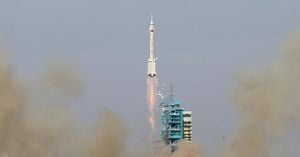In the fast-evolving world of artificial intelligence and high-performance computing, two industry giants—Google and Cipher Mining Inc.—are making waves with ambitious infrastructure projects and headline-grabbing partnerships. As of November 23, 2025, both companies find themselves at the center of a massive technological build-out, grappling with challenges that range from hardware shortages to energy constraints, while also seizing new opportunities that could redefine their futures.
Google’s AI ambitions are nothing short of staggering. According to CNBC, Google Cloud Vice President Amin Vahdat recently told employees that the company must double its AI computing power every six months, aiming to scale operations another 1,000 times within the next four to five years. The catch? They have to achieve this without ballooning costs or energy consumption. Vahdat emphasized the gravity of the situation, noting, “We have to build an infrastructure that is more reliable, performant and scalable than the solutions available today.”
The company’s scaling efforts are hampered by a global shortage of Nvidia GPUs, which are essential for training and deploying advanced AI models. Nvidia’s own quarterly report confirmed that its chips are “sold out,” a bottleneck that’s already impacting Google’s technology rollout schedule. Google CEO Sundar Pichai pointed to the Veo tool—a promising AI application that failed to expand to more users due to these very capacity limits. Despite these hurdles, Pichai assured employees that the company is committed to accelerating its infrastructure development, even as he acknowledged that concerns about the AI market overheating are “definitely relevant.”
To reduce reliance on Nvidia, Google is investing heavily in its own silicon. In November 2025, the tech giant unveiled its seventh-generation TPU processors, which are nearly 30 times more energy efficient than their first iteration. These chips, along with planned optimizations to AI model architectures and an expansion of physical data centers, are core to Google’s strategy for meeting skyrocketing demand. Pichai warned that 2026 would be a “busy year” as competition intensifies and demand for cloud services continues to surge.
But Google isn’t alone in its infrastructure race. Cipher Mining Inc. (NASDAQ: CIFR), once known primarily as a Bitcoin miner, has rapidly transformed into a major player in the AI data center space. According to MarketBeat, Cipher received a “Moderate Buy” consensus rating from 17 analysts on November 23, 2025, with a 12-month average price target of $24.73—about 75% higher than its November 21 closing price of $14.15. This bullish sentiment reflects excitement over Cipher’s pivot to AI hosting and its string of high-profile contracts.
The most recent highlight is Cipher’s expanded partnership with Fluidstack, a Google-backed AI cloud platform. On November 20, Cipher announced a new 10-year high-performance computing (HPC) colocation agreement for an additional 39 megawatts (MW) of critical IT load at its Barber Lake site in Colorado City, Texas. This deal brings Fluidstack’s lease to the full 300 MW capacity at Barber Lake, fully contracting the site’s current resources. The contract is expected to generate approximately $830 million in revenue over the initial 10 years, with extension options that could potentially lift total revenues to $2 billion—and up to $9 billion across the broader partnership. Google, for its part, is deepening its support by backstopping an additional $333 million of Fluidstack’s lease obligations, bringing its total Google-related backstop support to $1.73 billion.
Just weeks earlier, Cipher announced a blockbuster $5.5 billion, 15-year AI lease agreement with Amazon Web Services (AWS). Under the deal, Cipher will provide 300 MW of turnkey space and power for AI workloads, with capacity to be delivered in two phases during 2026 and rent starting around August of that year. This AWS contract, anchored at a dedicated site in West Texas, was unveiled alongside Cipher’s Q3 2025 business update, which already showed a significant jump in revenue from Bitcoin mining.
Between AWS and Fluidstack, Cipher now has 600 MW contracted across its Barber Lake and other projects, according to Barron’s. The company is prioritizing a development pipeline of roughly 3.2 gigawatts (GW) for HPC, with the potential to expand to 3.8 GW over time. Greg Miller, an analyst at Citizens JMP, estimates that if Cipher successfully leases out its full pipeline, the company could be worth far more than current targets suggest—though this scenario will require years of execution and billions in capital.
Of course, none of this comes cheap. Cipher has layered on significant debt to finance its expansion, issuing $333 million of additional 7.125% senior secured notes due November 15, 2030. After this offering, the company will have $1.733 billion in aggregate principal amount of these notes outstanding, with proceeds earmarked for further facilities at Barber Lake. This capital structure ties Cipher’s fate closely to the success of its AI build-out; long-term hosting cash flows will need to cover substantial interest obligations.
The company’s financials reflect its rapid evolution. In Q3 2025, Cipher reported revenue of about $72 million, mainly from Bitcoin mining, with 629 BTC mined and a total hash rate of 23.6 exahashes per second (EH/s) across five mining locations. Power capacity increased from 423 MW to 477 MW during the quarter, with the Black Pearl site’s Phase I (150 MW) responsible for around 10.1 EH/s—roughly 36% of Q3 production. Despite the AI pivot, Bitcoin mining remains a core revenue driver, leaving Cipher exposed to the volatility of crypto markets and potential regulatory shifts.
Stock performance has been nothing short of dramatic. Year-to-date gains through mid-November 2025 reached about 209.5%, outpacing peers and the broader tech sector. Yet, the stock remains volatile, with insider selling totaling over $280 million in the past three months. Director Holly Evans, for instance, sold 16,269 shares on November 12, 2025. MarketBeat data shows that insiders hold about 2.6% of the stock, while institutions hold just over 12%—though some sources suggest higher institutional participation when factoring in funds and derivative exposures.
Risk factors abound. Cipher’s leverage and fixed obligations, customer concentration with AWS, Fluidstack, and Google, as well as execution and construction risks for delivering AI-ready capacity by 2026-2027, all loom large. Commodity and regulatory risks from Bitcoin mining exposure and policy shifts in Texas power markets further complicate the picture. The recent launch of a new 2x leveraged ETF (CIFU) amplifies short-term volatility, making the stock a playground for active traders but a potential minefield for the faint of heart.
Looking ahead, investors are watching several key catalysts: the expected closing of the $333 million note offering around November 24, 2025; updates on the Barber Lake build-out; and further details on Cipher’s 3.2 GW+ HPC pipeline. For both Google and Cipher, the next chapter will hinge on their ability to turn massive infrastructure investments into sustainable, high-margin AI revenue—without letting risks get the better of them.
As the race to dominate AI infrastructure heats up, one thing is clear: the stakes have never been higher, and the winners will be those who can scale smartly, manage risk, and keep their eyes on both the bottom line and the horizon.




